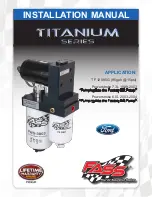
WWW.MANUALS.WS
WWW.MANUALS.WS
31
Inspect the belt system periodical-
ly. Check for cuts, fraying and
loose parts. Damaged parts
should be replaced. Do not disas-
semble or modify the system.
Keep the belts clean and dry. If
they need cleaning, use a mild
soap solution or lukewarm water.
Never use bleach, dye, or abrasive
cleaners-they may severely weak-
en the belts.
Replace the belt assembly (includ-
ing bolts) if it has been used in a
severe impact. The entire assem-
bly should be replaced even if
damage is not obvious.
Adjust the seat as needed (front seats
only) and sit up straight and well back
in the seat. To fasten your belt, pull it
out of the retractor and insert the tab
into the buckle.
You will hear a click when the tab locks
into the buckle.
The seat belt length automatically adjusts
to your size and the seat position.
The retractor will lock the belt during a
sudden stop or on impact. It also may lock
if you lean forward too quiclky. A slow,
easy motion will allow the belt to extend,
and you can move around freely.
If the seat belt cannot be pulled out of the
retractor, firmly pull the belt and release it.
You will then be able to smoothly pull the
belt out of the retractor.
When a passenger’s shoulder belt is com-
pletely extended and is then retracted
even slightly, the belt is locked in that posi-
tion and cannot be extended. This feature
is used to hold the child restraint system
securely. (For details, see “Child restraint”
in this chapter.) To free the belt again, fully
retract the belt and then pull the belt out
once more.
—Front seat belts and rear
outside seat belts
















































